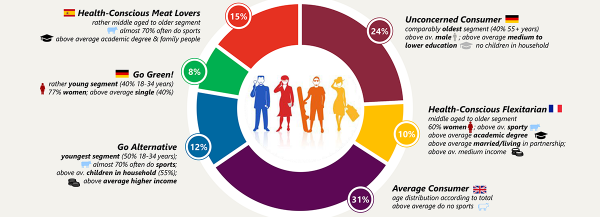Promotional Features
Decoding plant proteins to build the ideal alternative protein product
Plant proteins continue to gain momentum. Soy, pea, mycoprotein, algae … the list is growing, and growing fast. Whether driven by health, the environment, animal welfare, or a combination of concerns, many consumers want to embrace plant-based protein in its many shapes and sizes.
At the same time, from a product development perspective, significant challenges exist, because each protein source comes with very different taste profiles, attributes, and advantages. How do you pick the right one for your product? Most importantly, how can you ensure that it goes the extra mile in terms of taste? How do you do all this as quickly as possible to keep up with competitors and seize opportunities in a fast-moving market? When you consider these issues, the plant-based challenge seems daunting.
And the market lacks signs of slowing. In fact, in the US alone, plant protein products are expected to reach almost $18 billion by 2028, with an annual growth rate of almost 7%. Globally, the number looks huge, with some projecting it to reach north of $160 billion within ten years.
Understanding the consumer
According to well-known facts, globally, the consumer food market is moving toward naturalness and sustainability. Consumers want great taste and a cleaner label in the products they buy, and this especially applies to the alternative protein segment.
Symrise has used its expertise in market insights to dig deep into the mindset of consumers and their thoughts on alternative proteins. An online study has shown that consumers can be characterized by one of a number of segments:
Health Conscious Meat Lovers
Consumers in this group comprise traditional meat-eaters, most likely raised on animal proteins as the core of their diet. Meanwhile, they also understand the effects of diet on health and apply them to their lifestyle. They include middle-aged and older consumers, with above-average academic degrees. Typically, the focus on their families an active lifestyle, with almost 70% participating in some kind of sports activity. Around 15% of those surveyed fit this segment.
Go Green!
This segment, comprising 8% of those surveyed, predominantly includes young consumers in the 18-34 age group. They focus on going clean and green in their purchase behaviors. Mostly women, and about 40% make up this group.
Go Alternative
Like their Go Green counterparts, the Go Alternative segment is very aware of the trend towards naturalness and sustainability by taking it a step further with a focus on the protein content. They form the youngest segment and keep themselves very active in sports and fitness. They earn above-average income, and most live with children in the household.
Health-Conscious Flexitarians
By definition, flexitarians eat mostly plant-based foods, and they do allow animal proteins in moderation. Consumers in this segment tend to include middle-aged and older, well educated, with above-average incomes, with 60% women.
Unconcerned Consumers
Consumers in this segment with the oldest average age lack alternative proteins on their radar. They include male consumers, with medium to low education and no children in the household.
These segments, together with “Average Consumers” who behave indifferently towards plant protein products, represent the foundation of our understanding of what alternative proteins mean to the market.
The challenge: great taste and a clean label
Marketers are constantly evaluating ways to turn non-users of their brand into users, and current users into core users. Our research has shown that consumers who purchase plant protein products feel driven by some very distinct criteria. As expected, taste, and flavor rank at the top; if it tastes poor, they buy it only once. Artificialness and texture represent major stumbling blocks as well. Price also counts, while some consumer segments are likely paying more for what they perceive as healthy, natural, or sustainable. The plant protein source and the full ingredient list are all forming important purchase drivers, as does the nutritional value of the product.
Of course, “natural” delivers a key driver among these consumers. They want products that contain natural taste solutions or kitchen-like ingredients, whilst also fulfilling their nutritional requirements. They want minimal processing too, with a preference for ingredients that retain as much of nature as possible. When asked about their shopping behavior, they focus on these three front-of-pack claims: contains no additives or preservatives, environmentally friendly, and features reduced sugar, fat, or salt.
Future protein sources
When it comes to source materials for alternative proteins, one size hardly fits all. Soy, which will remain one of the most important plant proteins in the future, has to overcome some unfavorable characteristics related to monoculture, GMO, and allergens. Other protein sources such as pea, mycoprotein, chickpea, and algae will likely grow and foster biodiversity, flavor diversity, and a deeper focus on sustainability. These protein sources benefit from the fact that they require less processing and can be produced using water-based or physical extraction methods. Pseudo-cereals such as chia and amaranth are also rising, as are seeds like quinoa, buckwheat, flaxseed, and pumpkin. Potatoes as well have become a source of alternative protein.
Processing owns its role, too. Extrusion technology offers the potential for solutions with fewer off notes and better texture, while industrial-scale fermentation offers an exciting option for single-cell plants like spirulina and chlorella. Clean processing, such as the kitchen-like technologies mentioned earlier, come with inherent connotations of goodness and healthiness. Ingredient suppliers need to necessarily continue to innovate technologies that allow their products to maintain as much of the benefits found in their raw materials as possible.
Protein analysis and product development
The key to developing alternative protein products that meet these consumer demands lies in understanding and managing their different needs and in reducing complexity with AI-driven tools.
One example of this technology represents ProtiScan, a system developed by Symrise that allows the company to screen the different taste profiles of plant-based proteins and identify off-notes to accurately apply efficient taste balancing and taste solutions. It offers an analytical approach for the understanding and the assessment of alternative protein sources and applications.
Linking sensory and consumer-driven data allows Symrise to develop predictive models, resulting in efficient product development through well-suited and high-performing solutions. Proper utilization of unique analytical tools like ProtiScan can improve flavor release, enhance flavor performance, and control volatile (and non-volatile) off-notes. Ion Mobility Spectrometry (IMS) technology delivers vast amounts of data in a short space of time. When combined with consumer insights, this data can orientate the choice of protein, masking technologies, and enrichment approach.
A holistic approach to preferred consumer taste
Plant protein products have to pass the taste test, and they also have to pass the look and smell tests. One fact is complicating matters further. Some early adopters of plant protein products might think negatively about plant protein products due to bad previous experiences. Overcoming these barriers and delivering on the promise of great tasting plant protein products requires a well-rounded, holistic approach that combines consumer insights and innovative technology with expertise in flavor and taste balancing.
Today, we have to go beyond focusing on masking the off notes. Product developers also need to enrich and typify the inherent goodness found in plant proteins. This manifests in the product’s visual appearance, flavor, richness, and complexity. When developing plant protein solutions, Symrise adheres to a four-step process of masking, enrichment, flavor typification, and color/appearance to build the ideal alternative protein products. Only through this complete, 360-degree view we can successfully create consumer-preferred alternative protein products.









